Argomenti trattati
The rivalry between Kendrick Lamar and Drake has intrigued hip-hop fans ever since it began in 2013. What started as a friendly competition has morphed into a full-blown feud, filled with lyrical jabs, heated social media exchanges, and a barrage of diss tracks. In this article, we’ll explore the timeline of their conflict, shine a light on key moments, and delve into the broader cultural implications of their rivalry. Are you ready to take a deeper look into this fascinating saga?
The Origins of the Feud: From Friendship to Rivalry
Initially, Kendrick Lamar and Drake shared a cordial relationship. Back in 2011, they joined forces on the track “Buried Alive Interlude” from Drake’s hit album, *Take Care*. At that point, Drake was already a household name, while Lamar was just starting to carve out his space in the hip-hop landscape. Their early interactions were characterized by mutual admiration, with Lamar openly celebrating Drake’s artistic achievements. But everything changed with Lamar’s explosive verse on Big Sean’s track “Control” in August 2013, where he called out several rappers—including Drake—proclaiming his intention to dominate the genre. Who would have thought that one verse could ignite such a fierce rivalry?
After “Control”, the dynamics of their relationship began to shift. Although both artists publicly downplayed any tension, fans and critics couldn’t help but speculate about the simmering animosity. In the years that followed, they continued to take subtle digs at each other through their music, leading to an escalating series of responses that would define their ongoing rivalry. What started as respect quickly turned into something far more complex.
The Escalation: Key Moments and Diss Tracks
As the feud intensified, each artist dropped tracks that seemed to directly or indirectly address the other. A critical moment occurred in April 2024, when Lamar released his song “Like That”, which dismissed the idea of a ‘Big Three’ in contemporary hip-hop—a concept championed by J. Cole. Lamar’s bold lyric—“motherfuck the big three, nigga, it’s just big me”—was a clear shot at both Cole and Drake, reigniting tensions between them. What did it mean for the landscape of hip-hop?
In retaliation, Drake responded with tracks like “Push Ups” and “Taylor Made Freestyle”, both packed with personal attacks aimed at Lamar. The situation escalated further when Lamar unleashed “Euphoria” and “6:16 in LA”, each filled with pointed criticisms of Drake’s character and personal life. The exchanges became increasingly hostile, with both rappers using their platforms to amplify the feud. How do these public disputes reflect the evolution of hip-hop?
Drake’s accusations against Lamar included serious allegations of domestic abuse, while Lamar retaliated with claims regarding Drake’s personal life, including accusations of sexual misconduct. The personal nature of these attacks marked a significant turning point in their feud, drawing intense media attention and public scrutiny. It makes you wonder how far artists will go to defend their reputations.
Impact on Hip-Hop Culture and Public Perception
The ongoing feud between Lamar and Drake has ignited discussions about the future of hip-hop culture, its authenticity, and the implications of celebrity rivalries. Some commentators argue that their exchanges have enriched the genre, reigniting interest in lyrical skill, while others lament the deeply personal nature of their conflicts. What do you think? Has this rivalry helped or hurt hip-hop?
Public reactions have been as diverse as the artists themselves, with fans passionately defending their favorite while others criticize the personal attacks that have infiltrated the feud. The role of social media in escalating their rivalry raises important questions about its impact on contemporary music conflicts. Many have even labeled this ongoing spat as the last great rap beef, drawing parallels to the notorious East Coast-West Coast rivalry of the 1990s, which ended in tragedy. Is history repeating itself?
Ultimately, this rivalry has become a defining element of both artists’ careers. With each diss track and public statement, they’ve not only shaped their legacies but also influenced the broader narrative of hip-hop culture. The Kendrick Lamar and Drake feud stands as a significant chapter in the history of the genre. What legacy will they leave behind?

